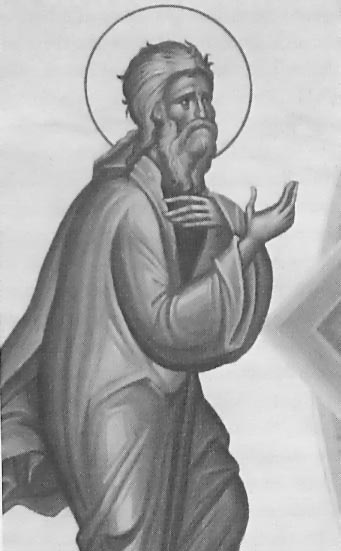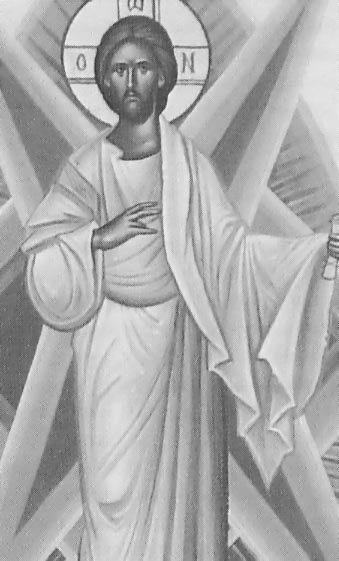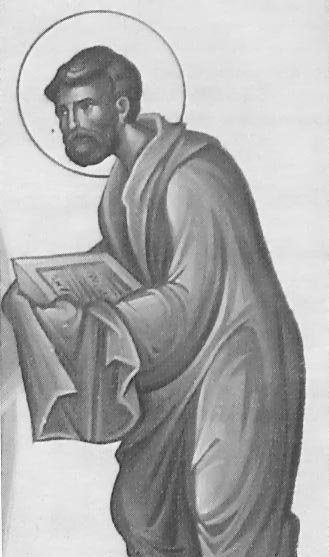THE VENERATION OF THE HOLY RELICS Rev. Dr. Dumitru Macaila "Do you not know that your body is the temple of the Holy Spirit who is in you, whom you have from God, and you are not your own?" (I Cor. 6.19) IN ONE OF HIS MASTERPIECES, ORTHODOX DOGMATIC THEOLOGY,* Fr. Dumitru Staniloae, considered by many scholars one of the greatest modern Orthodox Christian theologians, points out that while the Church venerates the relics of the saints, at the same time She honors the saints, with whom her militant members are in communion. | |
The very fact that the bodies of the saints are kept in a state of incorruptibility is a foretaste, an anticipation of their future incorruptibility after resurrection and after their full theosis, deification. "But we all," writes St. Paul to the Corinthians, "with unveiled face, beholding as in a mirror the glory of the Lord, are being transformed into the same image from glory to glory, just as by the Spirit of the Lord" (II Cor.3:18). | |
The bodies of the saints remain incorruptible because the divine power that dwelt in them when they were united with the soul still dwells in them. Moreover, stresses Fr. Staniloae, in the holy relics, the state of accentuated deification of their souls that was reached in this life, is prolonged after their falling asleep in Christ. Τhis is so, because the divine grace that dwelt in the saint's soul and sanctified it, doesn't forsake the body after death; it remains in the body and sanctifies it through incorruptibility to consummate deification. Holy relics are a clear anticipation of the transfigured body after universal resurrection. | |
Here is how St. Paul theologizes about universal resurrection: "So also is the resurrection of the dead. The body is sown in corruption, it is raised in incorruption. It is sown in dishonor, 'it is raised in glory. It is sown in weakness, it is raised in power. It is sown a natural | Holy relics are a clear anticipation of the transfigured body after universal ressurection |
| body, it is raised a spiritual body. There is a natural body, and there is a spiritual body... For this corruptible must put on incorruption, and this mortal must put on immortality" (I Cor.15:42-44; 53). Notice that, in his unique way, St. Paul realizes a contrast between the natural body, (Greek soma physikon), and the spiritual body, (Greek soma pneumatikon). Natural body is the present body, and the spiritual body is the deified body. Fr. Staniloae goes on to say that the bones of the saints, by remaining incorruptible, show us that their personal souls and the grace of the Holy Spirit remain in a special connection with their bodies. That is why, while giving veneration to the holy relics and praying before them, we do not address the relics, we address the saint. Our veneration is passed over to the person, something similar to the veneration of the holy icons. Bishop Kallistos Ware, in his' book The Orthodox Church, quotes St. Maximos the Confessor who said that the saints "are those who express the Holy Trinity in themselves." He writes that deification, theosis, as an organic and personal union between God and man, is a constant theme in St. John's Gospel, in St. Paul's Epistles, and more so in St. Peter's well known verse from his second universal Epistle: "By which have been given to us exceedingly great and precious promises, that through these you may be partakers of the divine nature, having escaped the corruption" (II Peterl:4). St. John Damascene, a.k.a. the theologian of the holy icons, emphasizes that when the Holy Scripture speaks about God, it doesn't speak about divine nature or essence, because that is unknowable. The word God refers to the uncreated divine energies, i.e., the grace of God that we can perceive in this world, and is "channeled" particularly through the holy Mysteries in the life of the Church. To quote St. Athanasios' very terse and familiar phrase "we become by grace what God is by nature." Deification takes place when God's grace interpenetrates our humanity. | |
Our love of God is made manifest through our love of neighbor. | Writes Bishop Kallistos Ware: "Deification is something that involves the body. Since man is a unity of body and soul, and since the Incarnate Christ has saved and redeemed the whole man,it follows that man'sbody is deified at the same time as his soul.. .The bodies of the saints will be outwardly transfigured by divine light, as Christ's body was transfigured on Mount Tabor" (The Orthodox Church, pp. 237-238). It is because of the transfiguration of the body together with the soul that the Orthodox Christians venerate the relics of the saints. Christ took on a human body to redeem not only our fallen humanity, but the whole creation, to realize a cosmic redemption. "What is of the earth remains earthly, and when fire consumes matter, it returns to the dust from which it came. But the divine fire neither destroys nor annihilates. The miracle of the burning bush is perpetuated in eternity. The fire will kindle the whole world. The entire creation will some day be permeated by divine rays" (The Living God, p. 91). |
| That Christ took on a human flesh to redeem not only our fallen humanity, but the whole creation, is crystal clear from St. Paul's words: "because the creation itself also will be delivered from the bondage of corruption into the glorious liberty of the children of God. For we know that the whole creation groans and labors with birth pangs until now" (Rom.8:21-22). | |
Further on, Bishop Kallistos makes six excellent points; these points may help those who have a hard time understanding the notion of deification of the body and the cosmic redemption from an Orthodox point of view. He stresses, first, that theosis is intended as the ultimate goal for every human being, for every true Christian. True, we shall be completely deified at the Last Day, but the process of deification begins now. It begins at Baptism when one receives the new nature from |    |
| Christ. From the very moment of Baptism, so long as one struggles to love God and obey His commandments, no matter how weak one may be, to some degree he is deified. | |
Secondly, even if one is being deified, it does not make him immune to sin. Deification presupposes continuous repentance. No matter how deified a saint may be, he never loses sight of his sinfulness: "Therefore let him who thinks he stands take heed lest he fall" (I Cor.1O:12). "No one can stop sinning simply by deciding that he will no longer do so. Even if a man became 'perfect' through his own efforts, he would risk being very far from God and complacent in his virtue. Proud of his conquest - of his victory over his body, over human nature - he would fall into the sin of pride. Only love and a heart open to God, to His grace and to that uncreated Light which He gives to us can make us like God" (The Living God, p. 89). St. Sisoes the Great, a great man of unceasing prayer, who is commemorated on July 6, begged the angels who came to take his soul to allow him one more hour to pray; he did this because he was not certain that he repented enough. He understood that the road to final transfiguration is called, "repentance". That is why either from the pulpit or in some of my previous articles many a time I identified this holy Mystery with the very "seal" of our salvation. Woe unto those who expunged it from their "Christian" life! I have in mind not only those who do not have this holy Mystery in their "Christian" denomination, but those who are nominal Orthodox Christians, also! Thirdly, Bishop Kallistos Ware points out that, there is no secret about what one must do in order to be deified. The man who approached Christ with the question: "Good Teacher, what shall I do that I may inherit eternal life?" received the answer: "You know the commandments..." Yet, this proved not to be enough, because Christ admonished him: "One thing you lack: Go your way, sell whatever you have and give to the poor, and you will have treasure in heaven; and come, take up the cross, and follow Me" (Mark 10:17, 19,21). So, keep the commandments, and practice your faith, do whatever your faith exhorts you to do. In other words, be a true, not a nominal Orthodox Christian! | |
 If someojne says, "I love God," and hates his brother, he is a liar; for he who does not love his brother whom he has never seen, how can he love God whom he has not seen? | Fourthly, in order for one to be deified, one has to live in a community. Our love of God is made manifest through our love of neighbor. St. John the Theologian makes this point plainly, straightforwardly: "If someone says, 'I love God,' and hates his brother, he is a liar; for he who does not love his brother whom he has seen, how can he love God whom he has not seen?" (I John4:20). "Man, made in the image of the Trinity, can only realize the divine likeness if he lives a common life such as the Blessed Trinity lives: as the Three Persons of the Godhead 'dwell' in one another, so a man must' dwell' in his fellow men, living not for himself alone, but in and for others," writes on Bishop Kallistos (The Orthodox Church, p.241). Theologian Thomas Hopko is known to have coined the phrase that the only place one may go alone is called hell. In loving one's neighbor with a Christly love, is the safest way for one to attain deification. |
Fifthly, love of God and love of neighbor must be practical. True, deification implies deep mystical experience, but it must be followed by actions to make it "flourish." It was out of their mystical experience that the greatest saints of the Orthodox calendar did not avoid the sick, the underprivileged and the poor of this world. It is an historical fact that even the great hermits used to comeback to the cities at least once a year to make their mystical experience in the heart of the wilderness flourish. Last but not least, deification presupposes life in the Church. It means that one avails oneself of the holy Mysteries, as divinely established channels by which the grace of God is poured into our souls. Christ purchased the Church with His own blood to offer us the means by which we may be sanctified to attain to divine likeness, deification. The most irrefutable biblical foundation for the veneration of the holy relics is found in the Old Testament. After Elisha, Elias' disciple, died, "It came to pass, as they were burying a man, that, behold, they spied a band of men; and they cast the man into the sepulcher of Elisha: and when the man was let down, and touched the bones of Elisha, he revived and stood up on his feet" (II Kings14:21). In the New Testament we read that, "believers were increasingly added to the Lord.. .so that they brought the sick out into the streets and laid them on beds and couches, that at least the shadow of Peter passing by might fall on some of them" (Acts 5:15). Also, "God worked unusual miracles by the hands of Paul, so that even handkerchiefs or aprons were brought from his body to the sick, and the diseases left them and the evil spirits went out of them" (Acts 19:11-12). So, the Orthodox Church, based on Holy Scripture and Sacred Tradition, has given due veneration to the holy relics. She collected and preserved the remains of the saints as far back as the second century. One early Church eyewitness gives a vivid testimony while describing the martyrly death of St. Ignatius the God-Bearer, Bishop of Antioch (+115), in Rome: "Of what remained from his body (he was torn to pieces by beasts in the circus), only the firmest parts were taken away to Antioch and placed in a linen as an invaluable treasure of the grace that dwelt in the martyr, a treasure left to the holy Church." Also, after St. Polycarp, Bishop of Smyrna (+156), has been burned to death by the Roman proconsul, his followers "gathered his bones as a treasure more precious than precious stones and purer than gold, and placed them.. .for the celebration of the day of his martyrly birth, and for the instruction and confirmation of future Christians." Moreover, the Church has shown honor to holy relics bysolemnly uncovering and translating them, by building churches over them, by establishing feasts in memory of their uncovering and translation, in adorning their tombs and encouraging pilgrimages to them, and most importantly, in the constant rule of the Church to place holy relics at the dedication of altars, as well as to place them in the holy antimension which is indispensable for the celebration of the Divine Liturgy. The holy Fathers of the "one, holy, catholic, and apostolic Church" have testified before their flocks of the miracles occurring from the holy relics, and many times they have called their faithful to be witnesses of the truth of their words. We mention among them some of the most prominent saints: St. Gregory the Theologian, St. Ephraim the Syrian, St. John Chrysostom, St. Ambrose, Blessed Augustine. We have to mention, also, that, the holy relics, (Greek τα λειψαα; Latin reliquiae, meaning "what is left"), are venerated even if they are not incorrupt, out of respect for the saintly life or the martyrly death of the saint. In fact, the local Synod of Moscow of 1667, among some other synods, has forbidden the recognition of the reposed as saints solely by the sign of the incorruption of their bodies. This does not mean that the incorruption of the saints' bodies is no longer unanimously seen as one of the divine signs of their sanctity. The veneration may become more accentuated when there are evident signs of healing by prayer to the saints for their intercession with God. I cannot conclude without mentioning the idea advanced by Fr. Michael Pomazansky, with which I am fully in agreement. In his book Orthodox Dogmatic Theology , in one of the footnotes he writes that, "One may say that the incorruption of a dead body is no guarantee of sanctity: examples can be given of Oriental swamis whose bodies were incorrupt long after death (whether by some natural means related to their ascetic life, or by a demonic counterfeit); and of some great Orthodox saints (for example, St. Seraphim of Sarov, St. Herman of Alaska) there remain only bones. The relics of St. Nectarios of Pentapolis (+1920) were incorrupt for several years, and then quickly decayed, leaving only fragrant bones" (pp. 326327). "Do you not know that your body is the temple of the Holy Spirit who is in you, whom you have from God, and you are not your own?" asks St. Paul (I Cor.6:19; see also II Cor.6:16). He wants his Corinthian disciples to understand that every individual whose nature was renewed by Christ through the bath of Baptism is a dwelling place of the Holy Spirit. Shortly after Baptism, the newly illumined receives his/her personal Pentecost, the holy Mystery of Chrismation. The saints succeeded in perpetuating the Church's Pentecost, and their incorrupt relics are living witness of the presence of the Holy Spirit. It is with deep theological meaning that our bimillenary Orthodox Church celebrates all of the known saints, but especially those who are known only by God, on the first Sunday after Pentecost, a. k. a. Sunday of All Saints. They attained to God's likeness by allowing God to reign on the only place where God cannot "reign without our consent," on the throne their own heart. They became by grace what God is by nature, the only goal set to every human being though Christ's Incarnation, the only goal of a true follower of Christ. Rev. Dr. Dumitru Macaila is the pastor of SS. Constantine .& Helen Greek Orthodox Church in Swansea, Illinois. * Romanian title of Fr. Staniloae's book is Teologia Dogmatica Ortodoxa, and was published in three volumes in 1978 at Bucharest, Romania. First volume was already translated into English, in two volumes, with the title The Experience of God. For the introductory paragraphs I used volume 3 of the book printed in Romanian language, pp. 349-350. (BIBLIOGRAPHY) Pr. Prof. Dr. Dumitru Staniloae, Teologia Dogmatica Ortodoxa, vol. 3, Editura lnstitutului Biblic si de Misiune of Bisericii Ortodoxe Romane, 1978. Timothy Ware, The Orthodox Church, Penguin Books, 1991. The Living God, A Catechism for the Christian Faith, translated from the French by Olga Dunlop, St. Vladimir's Seminary Press, 1989. Father Michael Pomazansky, Orthodox Dogmatic Theology, translated and edited by Hieromonk Seraphim Rose, Saint Herman of Alaska Brotherhood, 1994. Source: http://www.helleniccomserve.com/veneration.html | |
Welcome
EMASS 2010 will be hosted by the Early Medieval and Viking Age Research Group at UCD School of Archaeology in May 2010. A call for papers will be announced in due course, but if there are any queries please contact us at info@emass2010.com.
About EMASS
The Early Medieval Archaeology Student Symposium is an interactive forum run for and by graduate research students who focus on the archaeology of the Early Medieval period, roughly the period between the 4th-12th centuries AD. EMASS aims to provide a constructive and interdisciplinary forum to facilitate discussion and debate between researchers from different institutions and specialities, in a friendly and helpful environment. The annual EMASS conference, previously held in Cardifff, Exeter, and Sheffield is the primary venue for this discussion.
UCD School of Archaeology is looking forward to hosting EMASS in 2010. The School is home to the active Early Medieval and Viking Age Research Group (EMVARG), with post-graduate projects ranging from iron working in early medieval Ireland, to the significance of dress and ornament in bodily identity, to wood-turning in Viking Age and Hiberno-Norse Ireland, and to the archaeology of early medieval religious manuscripts. Other early medieval research ongoing at the School includes the prestigious INSTAR funded Early Medieval Archaeology Project amongst other work.
The group is not restricted to students who are in full-time education and would like to invite early career researchers to join in the discussion. We also welcome early medieval researchers from across the globe and from any discipline to become involved! Please check out the EMASS website for more information, including the EMASS manifesto, the mailing list, and previous publications.
UCD School of Archaeology is looking forward to hosting EMASS in 2010. The School is home to the active Early Medieval and Viking Age Research Group (EMVARG), with post-graduate projects ranging from iron working in early medieval Ireland, to the significance of dress and ornament in bodily identity, to wood-turning in Viking Age and Hiberno-Norse Ireland, and to the archaeology of early medieval religious manuscripts. Other early medieval research ongoing at the School includes the prestigious INSTAR funded Early Medieval Archaeology Project amongst other work.
The group is not restricted to students who are in full-time education and would like to invite early career researchers to join in the discussion. We also welcome early medieval researchers from across the globe and from any discipline to become involved! Please check out the EMASS website for more information, including the EMASS manifesto, the mailing list, and previous publications.
Call for Papers
Deadline:1 March 2010
We are pleased to announce that the 4th annual EMASS symposium will be held in University College Dublin on 19-20 May 2010.
We would like to invite submissions for papers of c.20 minutes duration on any aspect of the early medieval period (400-1200AD) from any part of the world. In keeping with EMASS tradition, there is no set theme for the symposium but papers addressing theory in the early medieval period are particularly welcome, as are papers addressing other approaches such as experimental archaeology. As this is the first time that EMASS will visit Ireland, we also invite papers addressing ideas of regionality and difference in the early medieval period.
Current and recent postgraduate students as well as early career researchers are welcome to present and attend. Poster presentations are also invited, especially from those who may not be able to attend the symposium.
Please send your abstracts (200 words) by email to: info@emass2010.com or to EMASS 2010, UCD School of Archaeology, Newman Building, Belfield, Dublin 4, Ireland.
Registration Fee - €20 (includes registration, refreshments and wine reception).
We are pleased to announce that the 4th annual EMASS symposium will be held in University College Dublin on 19-20 May 2010.
We would like to invite submissions for papers of c.20 minutes duration on any aspect of the early medieval period (400-1200AD) from any part of the world. In keeping with EMASS tradition, there is no set theme for the symposium but papers addressing theory in the early medieval period are particularly welcome, as are papers addressing other approaches such as experimental archaeology. As this is the first time that EMASS will visit Ireland, we also invite papers addressing ideas of regionality and difference in the early medieval period.
Current and recent postgraduate students as well as early career researchers are welcome to present and attend. Poster presentations are also invited, especially from those who may not be able to attend the symposium.
Please send your abstracts (200 words) by email to: info@emass2010.com or to EMASS 2010, UCD School of Archaeology, Newman Building, Belfield, Dublin 4, Ireland.
Registration Fee - €20 (includes registration, refreshments and wine reception).
Source: http://www.emass2010.com


 Δεκατέσσερις φορές απειλές από τηλεφώνου και αναρίθμητα e-mail:
Δεκατέσσερις φορές απειλές από τηλεφώνου και αναρίθμητα e-mail:






















 This exhibition of approximately 70 works explores the emergence and transformation of several key types of reliquary, moving from an age in which saintly remains were enshrined within closed containers to an era in which relics were increasingly presented directly to worshipers.
This exhibition of approximately 70 works explores the emergence and transformation of several key types of reliquary, moving from an age in which saintly remains were enshrined within closed containers to an era in which relics were increasingly presented directly to worshipers.


